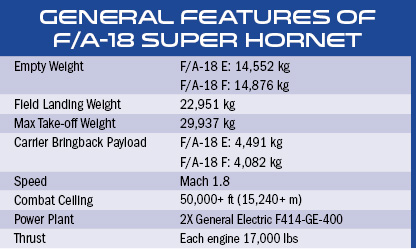INDIAN ARMED FORCES CHIEFS ON
OUR RELENTLESS AND FOCUSED PUBLISHING EFFORTS

SP Guide Publications puts forth a well compiled articulation of issues, pursuits and accomplishments of the Indian Army, over the years

I am confident that SP Guide Publications would continue to inform, inspire and influence.

My compliments to SP Guide Publications for informative and credible reportage on contemporary aerospace issues over the past six decades.
F/A-18 by Boeing
In all likelihood, India may prefer the twin-engine F/A-18s over the single-engine F-16s which is also on offer. Besides, the Indian Navy could also consider the carrier version of the F/A-18s for its requirement in the future.

The F/A-18 E/F Super Hornet manufactured by Boeing is the newest, highly capable and affordable tactical aircraft available in the inventory of the US Navy. The Super Hornet is currently the backbone of the US Navy carrier air wings and is expected to be so through to 2040.
Evolution of the Super Hornet
The first operational F/A-18 E/F Super Hornet squadron was formed in June 2001 and was deployed in the combat role aboard the USS Abraham Lincoln in July 2002. In April 2005, Boeing delivered the first Block II Super Hornet, complete with the world’s first tactical multi-mode AESA radar and it became fully operational at the end of 2007. Since inception, the Super Hornet programme has remained on time and on cost. The US Navy Super Hornet programme of record is 563 aircraft. Current backlog including orders in fiscal year 2016, takes deliveries into 2018. Kuwait and additional domestic fiscal year 2017 and fiscal year 2018 orders take deliveries into 2020. This provides a bridge to future international opportunities and future needs of the US Navy.
In May 2007, the Commonwealth of Australia ordered 24 F/A-18F Super Hornets, becoming the first international Super Hornet customer. The Royal Australian Air Force’s (RAAF) aircraft were all delivered to Australia’s RAAF Base Amberley, completing delivery ahead of schedule in October 2011. In May, Australia announced plans to acquire 12 new EA-18 Growlers, the airborne electronic attack derivative of the Super Hornet.
In August 2013, Boeing and Northrop Grumman conducted flight tests with a prototype of an Advanced Super Hornet aircraft with conformal fuel tanks; an enclosed weapons pod and signature enhancements. These capabilities, along with other planned advanced technologies to include enhanced engines, internal infrared search and track, and a nextgen cockpit, offer domestic and international customers a menu of next-generation capabilities that will allow Super Hornets to outpace threats in the 2030+ threat environment at affordable cost.

Under a contract awarded in 2011, Super Hornets are currently planned to be deployed by 2017 with an upgraded Infrared Search and Track (IRST) sensor system that will perform long-range targeting weapons quality tracking, thus broadening the US Navy’s war-fighting capability. The first successful flight test of IRST was carried out in February 2014. The US Navy approved the IRST system to enter low-rate initial production in January 2015.
Current Deployment
Operational in ten US Navy Carrier Air Wings (25 squadrons) and the Royal Australian Air Force, the combat-proven Super Hornet delivers cutting-edge, next-generation multi-role strike fighter capability, outdistancing current and emerging threats well into the future. The Super Hornet has the capability, flexibility and performance necessary to modernise the air force or the naval aviation wing of any country. Built by the industry team of Boeing, Northrop Grumman, GE Aviation and Raytheon, the Super Hornet provides the war-fighter with the newest advances in capability and growth in missions, roles and technology for decades to come. Its suite of integrated and networked systems provides enhanced interoperability and support for ground forces as well as for the overall force commander.
Two versions of the Super Hornet – the single-seat E model and the two-seat F model — are in production today and in worldwide service with the US Navy. The Royal Australian Air Force operates 24 F model Super Hornets. Both models are true multi-role aircraft, able to perform virtually every mission in the tactical spectrum, including air superiority, day/night strike with precision-guided weapons, fighter escort, close air support, suppression of enemy air defences, maritime strike, reconnaissance, forward air control and tanker missions.
Operational Capability
With 11 weapons stations, the Super Hornet gives war-fighters extraordinary payload flexibility by carrying more than 400 configurations of air-toair and air-to-ground ordnance. A typical basic weapon load for a self-escort strike mission starts with an advanced infrared targeting pod, one AIM-120 AMRAAM, two AIM-9 Sidewinder missiles, a 20mm cannon and an external fuel tank. This leaves six under-wing weapon stations available to carry a variety of weapons and other stores.

Through an evolutionary, modular approach, including the addition of the APG-79 active electronically scanned array (AESA) radar, the Super Hornet offers continuously improving overall mission capability and supportability. Integrating the APG-79 AESA radar, Advanced Targeting Forward Looking Infrared system, Joint Helmet Mounted Cueing System, Multifunctional Information Distribution System, advanced high capacity computer system, and state-of-the-art cockpit provides the war-fighter with intuitive situational awareness and capability.
The F/A-18 E/F has exceptional combat manoeuvrability, unlimited angle of attack, high resistance to spins and departures, as well as ease of handling and training. Its reconfigurable digital flight control system can detect damage to or full loss of a flight control and still allow safe recovery. These and other enhancements ensure the Super Hornet remains combat relevant through the coming decades and have defined it as the safest tactical aircraft in the history of naval aviation. Two highly reliable General Electric F414-GE-400 engines power the Super Hornet. Increased airflow to the engine is provided through the Super Hornet’s large, distinctively shaped inlets. A full authority digital electronics control allows for unrestricted engine response in any phase of flight.
The Super Hornet has proven to be the most cost-effective aircraft in the US tactical aviation fleet, costing less per flight hour to operate than any other tactical aircraft in the inventory of the US forces, including single-engine aircraft such as the F-16.
The Super Hornet for India
The US Government has reportedly made an offer to supply the F/A-18 Super Hornet combat aircraft for the Indian Air Force (IAF) to be manufactured in the country under the ‘Make in India’ programme. With the strength of the combat fleet in the IAF down to 33 squadrons and the contract for the 36 French Rafale jets yet to be finalised, India is now actively considering the possibility of going in for this option. In all likelihood, India may prefer the twinengine F/A-18s over the single-engine F-16s which is also on offer. Besides, the Indian Navy could also consider the carrier version of the F/A-18s for its requirement in the future. Boeing has offered to set up a new-generation production line in India to manufacture these aircraft for India as well as for the global market.





